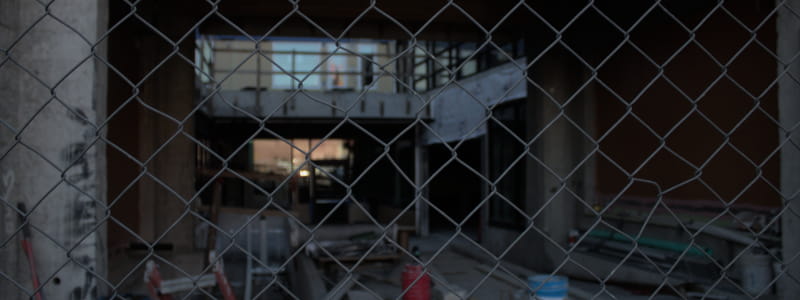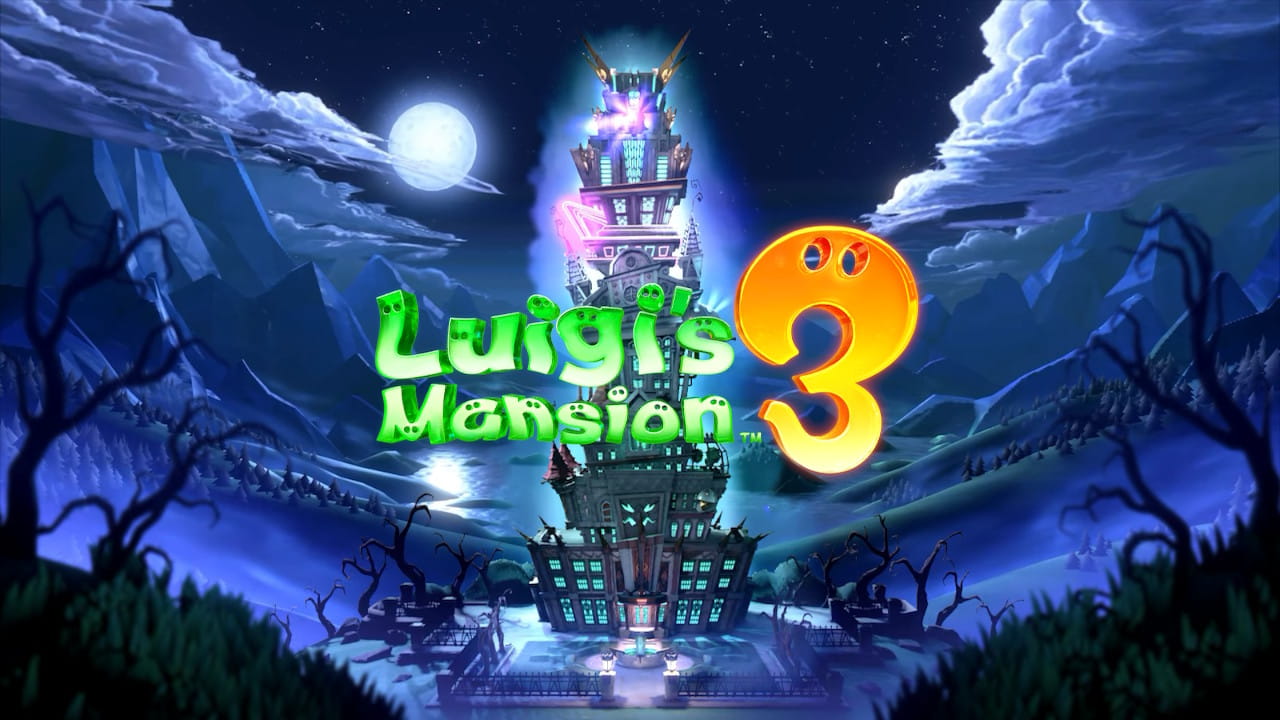
Luigi’s Mansion 3 is an ol’ familiar sweep o’ the rug under your feet. During my 1st 8 or so hours playing it I felt that this game melded the good elements from Dark Moon, such as the secret gems & the rainbow dark-light flashlight that reveals missing furniture, with fixing some o’ the complaints people had gainst Dark Moon, such as the mission system & E. Gadd constantly yapping @ you1, & adds extra mechanics, like the plunger shot & Gooigi2. I began to think that Luigi’s Mansion 3 did as I predicted it could in my comparison o’ the original vs. Dark Moon: easily besting its predecessors by doing the “1 big mansion, lots o’ freedom & exploration” thing. It does do that for the basement & the 1st 2 floors, before you enable the elevator, as these floors connect to each other naturally with stairs, creating a Metroidvania-like up & down that was not straightforward, like the 1st game did. But after that I noticed that the game devolved into simply going from floor to floor, with each floor being its own separate level, like Dark Moon’s separate mansions.
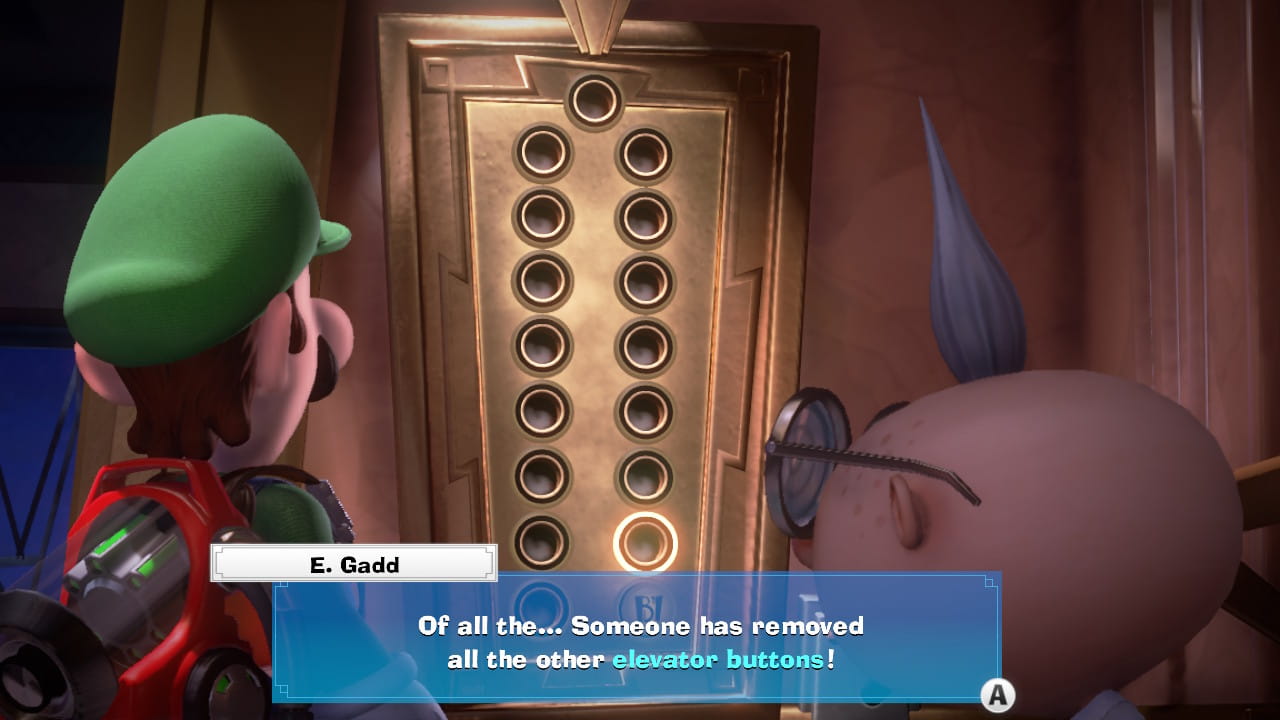
I should add that some o’ these “floors” have multiple floors themselves, which makes no sense, & is inconsistent with how floors 1 & 2 work. If you look @ the map & select floors 1 & 2 on the left, they will show floor 1 & 2 respectively selected on the right & selecting either o’ those right options will select the corresponding option on the left. This is the only time selecting a left option will have you default to the 2nd floor on the right. But if you select, say, floor 7, its right options will be 1, 2, & 3, & selecting any o’ these right options won’t change the left option. So, the right options represent the #’d floors o’ the hotel as a whole on floors 1 & 2, but represent subfloors on any other floor. I can only dream o’ what this game would be like if all o’ the floors connected to each other in the complex way that floors B1 to 2 do, with the elevator buttons as just pieces to that puzzle.
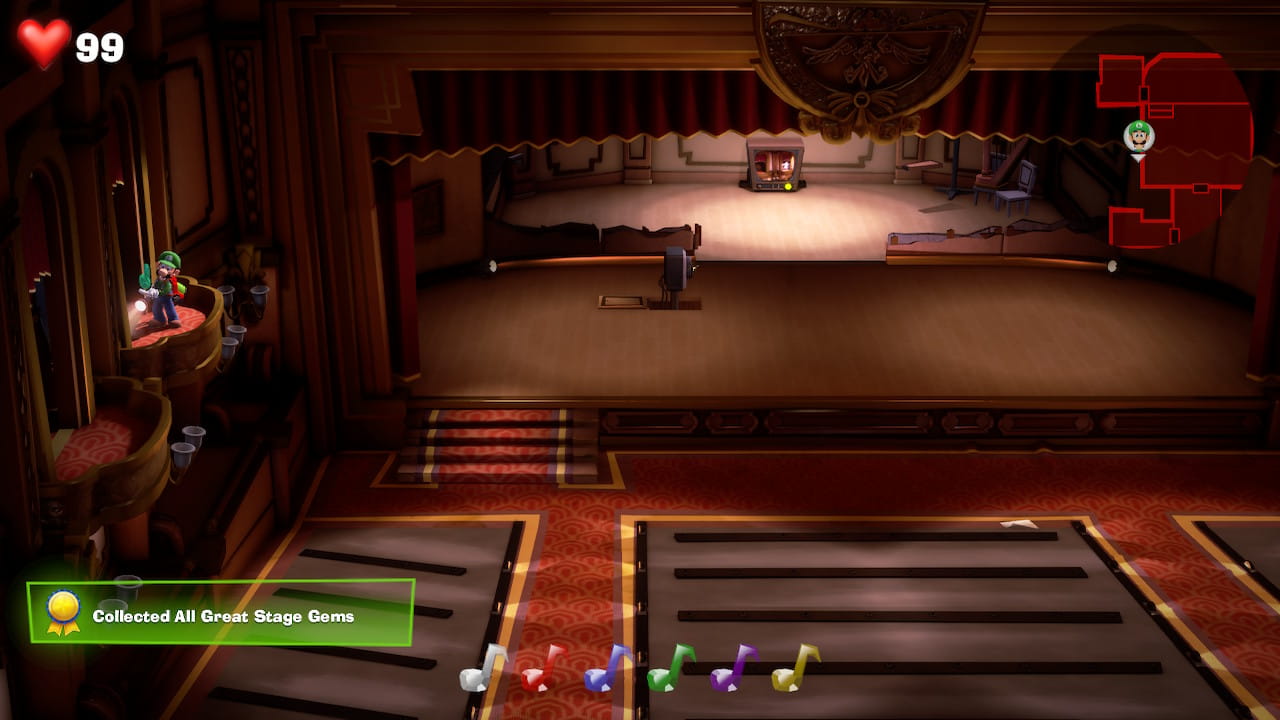
Thus, this game is a return to form to the original game & simply bullshits & pretends it isn’t divided into distinct linear sections, when they most certainly are. That said, Luigi’s Mansion 3 is free from the Super Mario Sunshine Syndrome bullshit o’ having to play thru the same areas in multiple missions just to find all the gems, as in Dark Moon, while having much better variety than both the original & Dark Moon. Still, it would be nice to finally see a Luigi’s Mansion game that was actually nonlinear.
I’m mixed on how the level themes are laid out. As you go up the hotel, floors begin to feel less like hotel floors & mo’ like other places, like a floor that’s a pirate cove, a garden, a desert tomb, & a medieval castle. Tho I defended Dark Moon for mixing its o’erall mansion theme with other themes, such as nature, desert tombs, & snow as being mo’ interesting than the original just sticking with a basic mansion, that game did a better job o’ keeping those levels grounded as mansions, with non-mansion elements feeling like exceptions. Floors like “The Spectral Catch” & specially “Tomb Suites” don’t feel much like they belong in a hotel @ all & feel mo’ like a ’scuse to have standard video game settings rather than be a hotel. But a’least this game has some mo’ exotic themes. While “Tomb Suites” is just a generic desert tomb, which had already been done in Dark Moon, & “Garden Suites”’s garden theme is hardly rare ( & was also done in Dark Moon ), the castle, pirate, disco club, museum, & shop themes feel a bit mo’ refreshing than Dark Moon’s mo’ standard themes; & I like how the game gradually makes floors mo’ exotic as you reach the middle-to-top floors, & then gradually goes back to normal as you reach the top, with the final floor being a normal hotel floor ’gain, as if the middle floors are a drug sequence that Luigi is not sure he truly experienced.
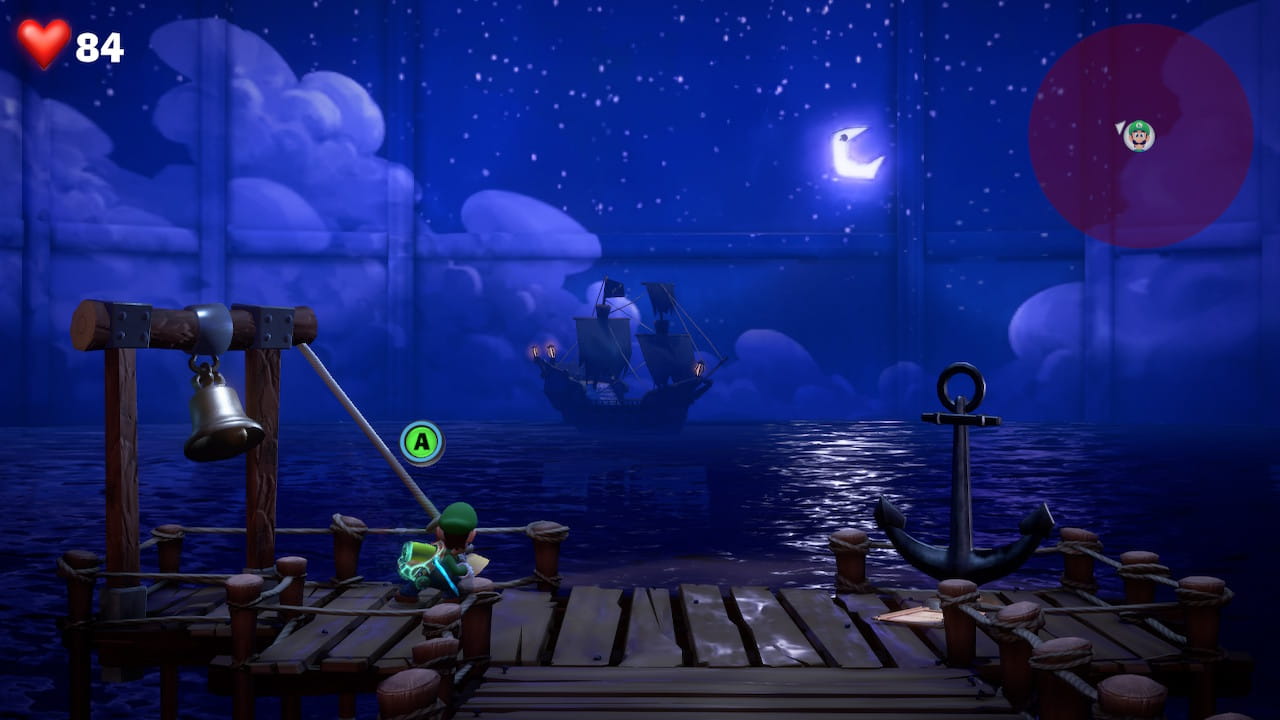
’Nother problem is that this game falls into Super Mario Odyssey Syndrome with some levels — most notably, “The Dance Hall” & “Unnatural History Museum” — way too short & underdeveloped. I wish they’d spent less time copying Dark Moon & other desert levels in bloating out “Tomb Suites” with trite Indiana Jones traps & spent mo’ time developing mo’ deserving levels with mo’ interesting, new themes like “The Dance Hall”. But then ’gain, like Super Mario Odyssey, it says something good ’bout this game’s levels that the main complaint one might have is them being too underdeveloped in a medium where developers try to bloat everything out as much as possible. & most games would probably wish they could have “Tomb Suites” as their worst level.
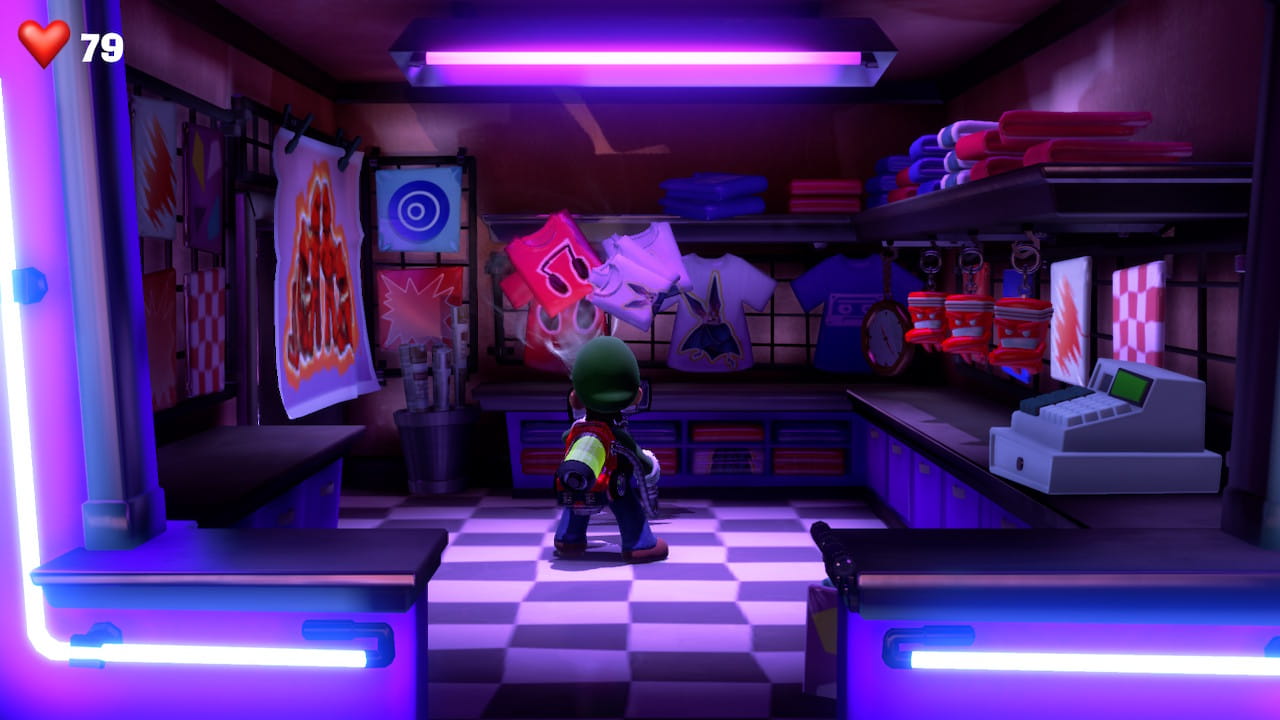
Still, this game had some interesting levels that did a better job o’ balancing this game’s o’erarching theme with creating a new theme that felt fresh, such as the “Fitness Center” with puzzles ranging from running on a treadmill to reveal items ( a subtle reference to the original Luigi’s Mansion ) to folding & unfolding yoga mats to match posters on the walls or “Twisted Suites”, with its gimmick o’ mixing up rooms so that doors warp you to a completely different room on the floor & rooms that seem to make a puzzle out o’ every magician cliché, from chained-up water tanks to optical illusion mirrors to rotated floors.
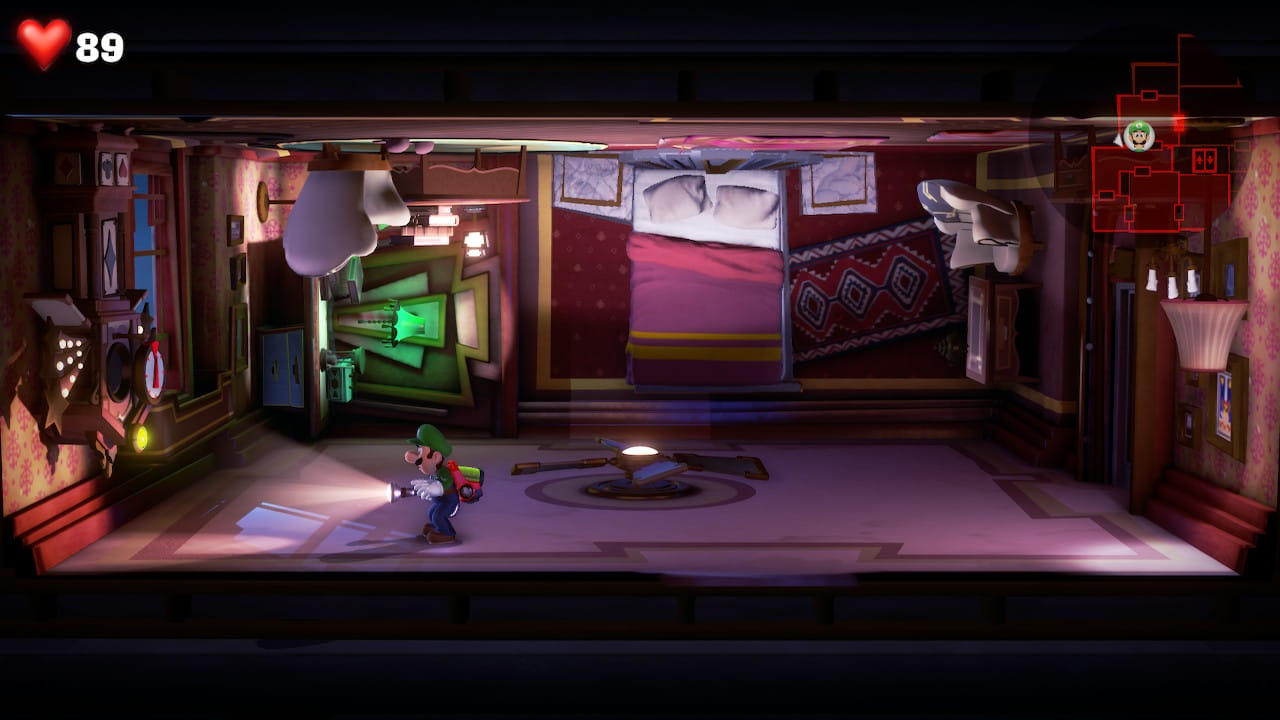
& while its mechanical/sewer theme is far from the most original theme, “Boilerworks” uses this theme to create clever puzzles involving you maneuvering Luigi round in an inflatable duck to avoid hitting spikes while Gooigi ’bove has to manipulate switches to open Luigi’s path without getting hit with the water all o’er the place, while also fitting perfectly its place in the 2nd basement floor. Some people may not like the return trip & consider it to be padding, but you don’t redo much o’ the floor on the return trip & I like the way the developers foreshadow this return with inaccessible paths ’hind brick walls. I only wish they hadn’t made the reason for the return trip as arbitrary as E. Gadd randomly sending a Toad there ’lone.
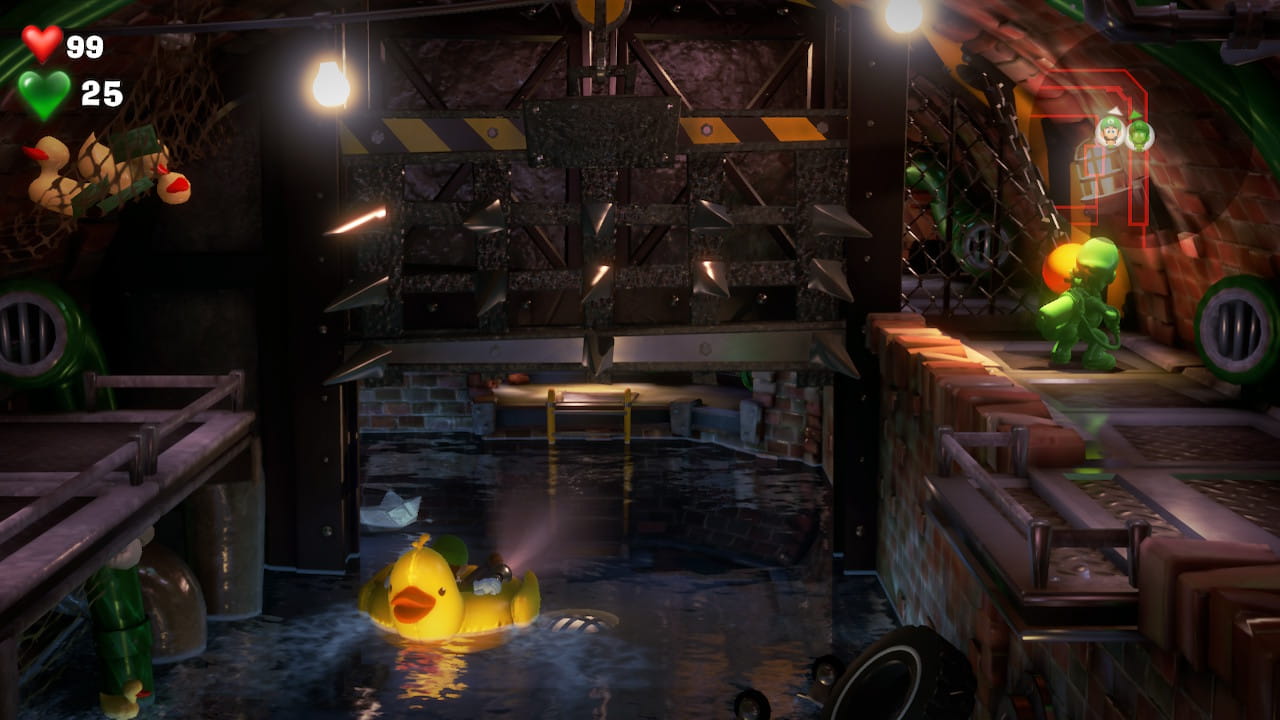
& then there’s “Paranormal Productions”, with its clever o’erarching puzzle involving warp TVs to movie sets parodying movies like The Ring or cheesy spider monster movies. Granted, much o’ the puzzle is technically fetch-questing; but the area is small ’nough that you don’t have to do too much travelling, & the game doesn’t spell out exactly what you need @ each part o’ the sequence like many fetch quests.
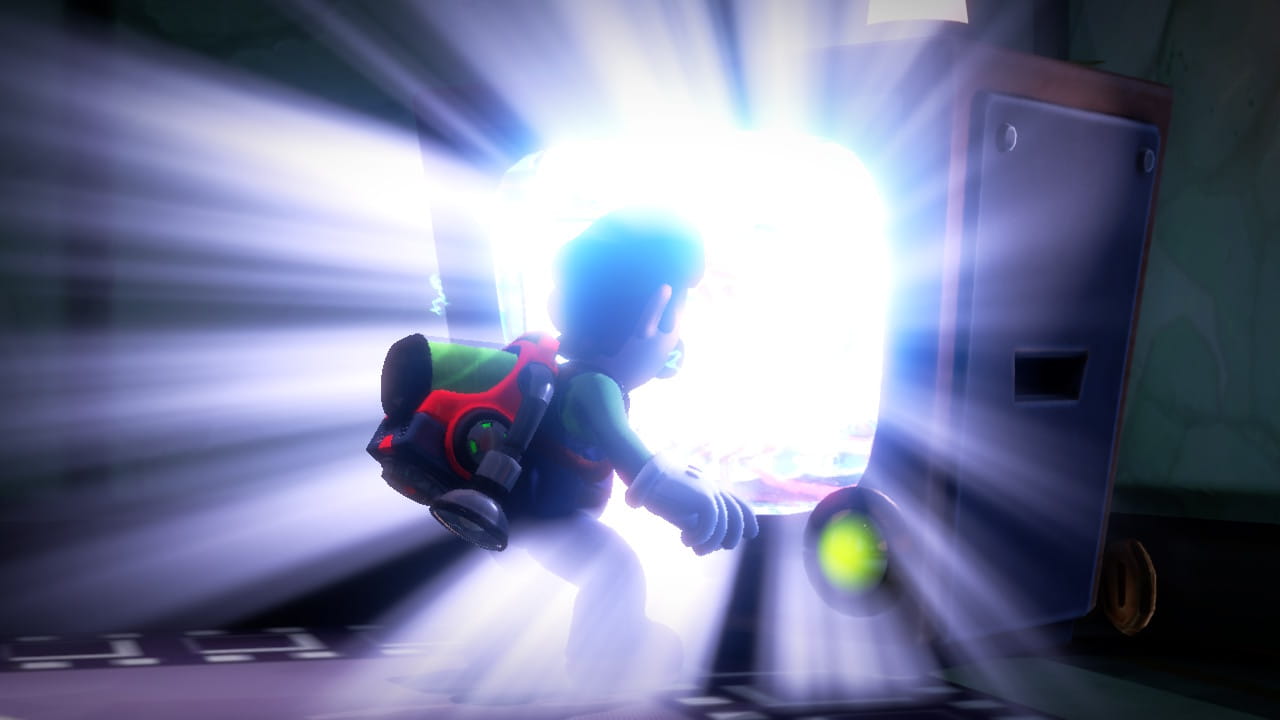
I’ve read complaints that the game starts boring with typical hotel floors round the beginning, but I like how the game warms you up to exploring hotel rooms before getting exotic. Also, I like how the basement & 1st & 2nd floors connect to each other, making them feel some cohesion that all the other floors lack.
1 subtle thing Luigi’s Mansion 3 has that its predecessors don’t is the sheer amount o’ destruction you can cause to all property you see. Not only can you suck up all papers or clothing you find, as in all games, but can also use the plunger shot to fling & break all manner o’ garbage cans, shelves, & potted plants. A particular highlight is on the 7th floor when you can grab a buzzsaw & shred thru everything: beds, couches, chests o’ drawers. It’s as if the Halloween spirit made the developers not only want Luigi to be a ghostbuster, but also a normal-sized Godzilla as well ( speaking o’ which: you can also destroy a shrunken set o’ buildings while fighting a ghost disguised as Godzilla ). Honestly, the funnest part o’ the game is just exploring the variety o’ environments & destroying everything you see for money, just like any good entrepreneur does.
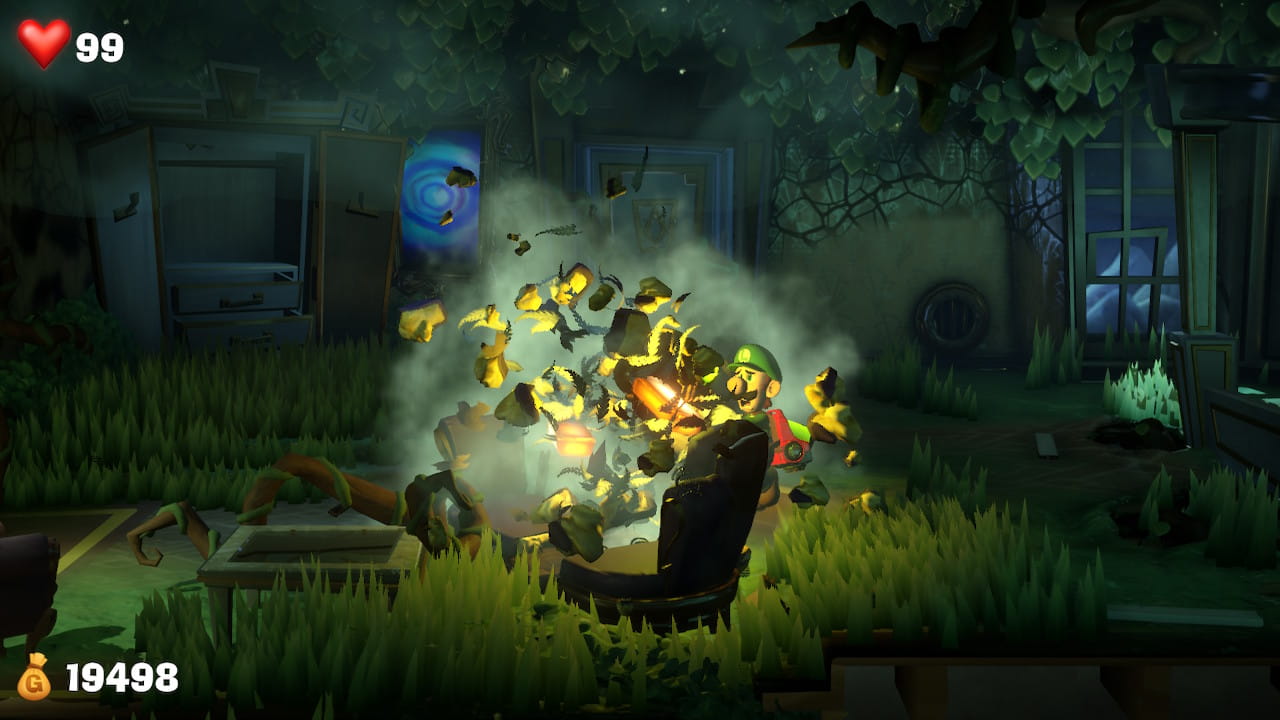
Still, while the Godzilla element was fun, the actual ghostbusting is less so: combat has not been made any less arbitrary, only now it’s streamlined ’nough that it gets o’er with faster — sort o’ a less extreme version o’ Ocarina of Time’s “press Z & let the game sword fight for you”. For instance, Luigi can swing ghosts back & forth as he is sucking them in, allowing you to hit other ghosts & prevent them from taking cheap shots from ’hind you, while also whittling down their HP before sucking them up, while also allowing you to break e’en mo’ shit. It’s not meaningful, mechanics-wise, but it is just a li’l mo’ fun. 1 problem this game has that the previous entries didn’t is that the game ne’er tells you that you have to press the A button right as you slam the ghost onto the ground to go fast ’nough to get mo’ slams & cut down on cycles, rather than mashing the A button, as one would intuitively guess, which is actually the least optimal way to handle slamming.
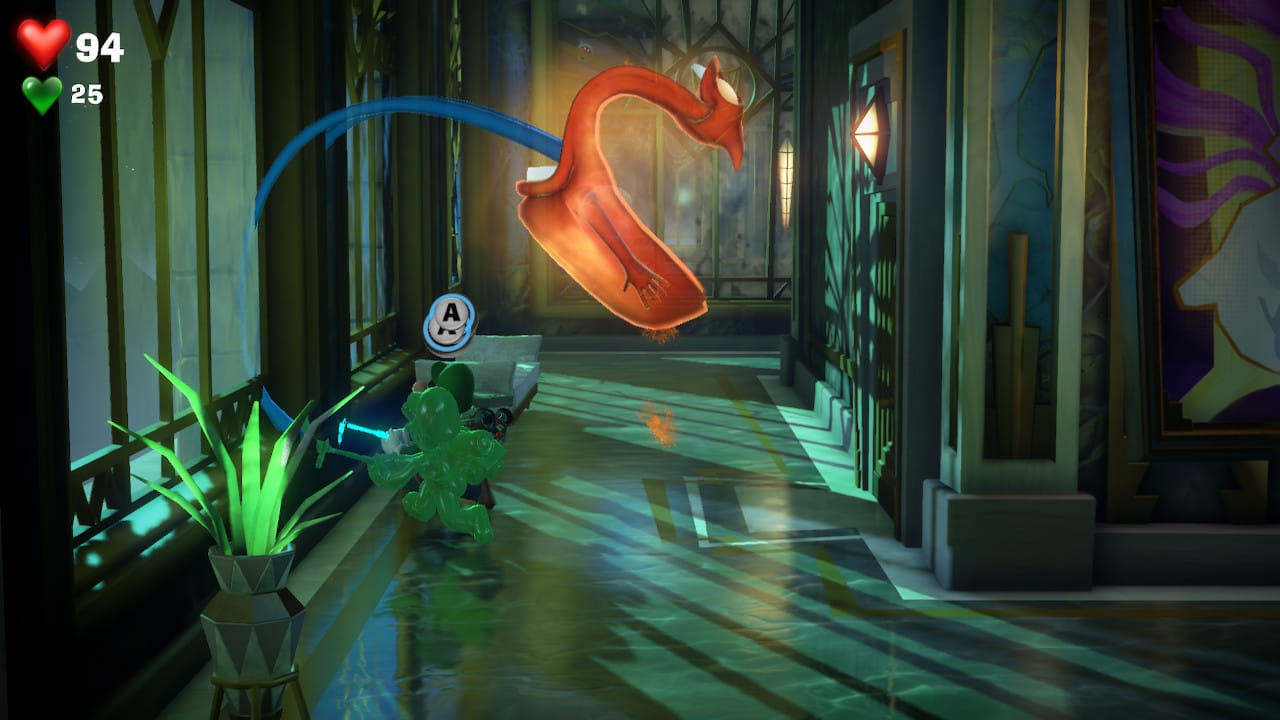
1 element that has become worse is the flashlight, which for some reason has piss-poor hit detection. The most blatant example I can give is when I had my light covering the inside o’ a barrel full o’ rats, flashed, & yet 1 rat somehow didn’t get killed, e’en tho there was nowhere in the barrel the light could have missed. Many bat $ have been lost repeatedly flashing straight up @ bats, only for the bats to not react @ all, e’en if the flashlight beam was right in their face. It’s light for fuck’s sake: it spreads. If the light is anywhere near a bat or rat it should hit it; ’stead trying to flash up @ a bat is like jabbing a thin needle up & trying to pierce one with it — which is to say, nothing like how light works in any sane realm. ’Nother problem, tho 1 that was in the 1st 2 games, is that when you aim your flashlight & then start moving, Luigi automatically moves his flashlight back down for no reason, forcing the player to use alternate buttons for using the flashlight to avoid holding the controller in a weird way to flash upward. Luckily, you can suck up enemies to collect their money, like in the original Luigi’s Mansion. It’s just unfortunate that I ne’er bothered to check since I just assumed the game worked the way Dark Moon.
The dark light, howe’er, has been improved, not only ’cause it’s used a bit mo’ sparingly than in Dark Moon, but also ’cause it no longer o’erheats, which was a mechanic that ne’er added anything to Dark Moon. They also added new enemies that are possessed garbage bins & treasure chests that are defeated with the dark light.

But what makes these nitpicks less o’ a problem in this game is that this game focuses a lot less on ghostbusting than previous games, emphasizing puzzle-solving e’en mo’ than Dark Moon. Since the ghost-catching mechanic was ne’er the most interesting element o’ the series, I consider this an improvement. Unlike Dark Moon & specially the original, which could sometimes feel monotonous with making you catch the same ghosts o’er & o’er ’gain, I don’t think I e’er felt like ghost-catching was o’erbearing in this game, save for maybe in the postgame, when you can just ignore them, anyway.
As mentioned, the game adds new mechanics to give a bit mo’ variety to a series that e’en in Dark Moon didn’t have much but a hammer to solve almost all puzzles. Some o’ these work well, like the plunger & Gooigi, while others feel tacked-on & janky, like the weird blast attack that on rare occassions is s’posed to be used as a wimpy jump, rather than, you know, let the 1 man who can jump better than the king o’ platformers, Mario, jump. Some people have criticized Gooigi for being a “flat character”, ’cause a rational person would certainly expect a Mario game to have the deep character exploration o’ a Henry James novel ’nother hurtfic character who does nothing, like Rosalina. But Gooigi’s character works perfectly for the game mechanics that he is used for, being a copy o’ Luigi who can move thru permeable surfaces, but dies to water, fire, or lasers, which is what’s actually important to a video game. Also, I don’t know, I find his uncanny valley blank-faced robotic behavior kind o’ funny. I found it hilarious that he’s standing round @ the end & nobody, including Mario, asks what this abomination gainst nature is & where it came from. “Sure, my brother just has a clone made out o’ slime that he can possess. Just ’nother day in the Mushroom Kingdom”.
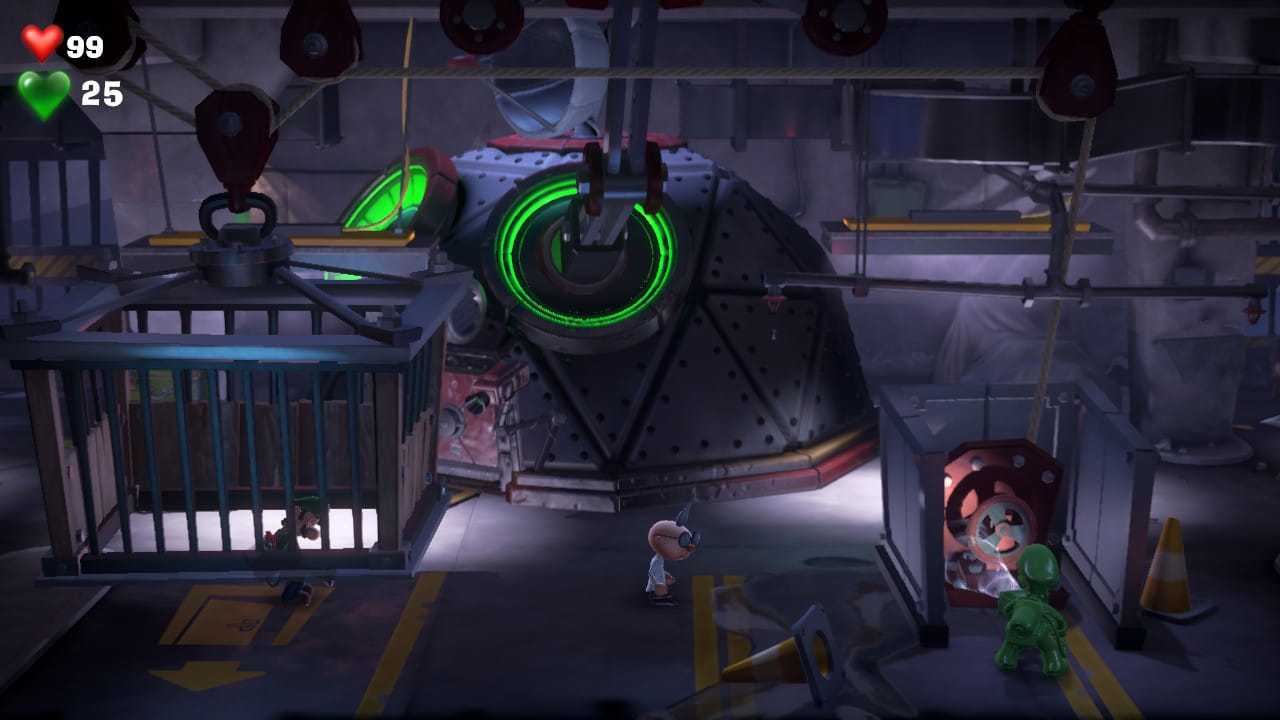
The problem with all these mechanics is that the game is inconsistent ’bout how effective they are. There is no logic to when you can stick a plunger to any surface, what the blast attack can or cannot break & whether enemies are stunned by the flashlight, dark-light, or blast attack. It’s a coin flip whether or not a ghost wearing shades will allow you to suck its shades up or require you to use your blast attack or whether a ghost with a shield will need you to yank it ’way with your plunger or blast it ’way with your blast attack.
Puzzles are hit & miss in this game. There are plenty o’ great puzzles thruout levels, such as the secret brick in “The Dance Hall” that you have to blast attack to jump under & hit to reveal coins like a classic Super Mario Bros. coin block, the weight puzzle in “Tomb Suites”, or most o’ the puzzles in “Boilerworks”, ’mong many others.
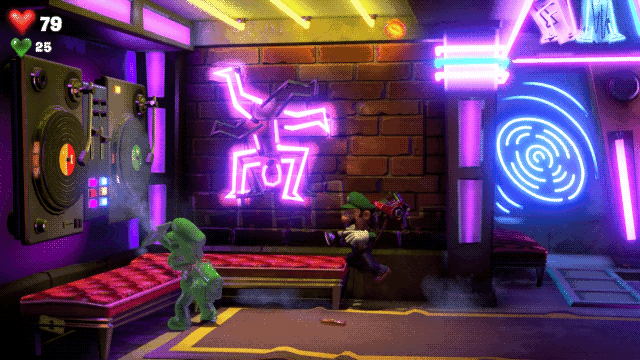
Then you have puzzles like the laser statue puzzle in “Tomb Suites”. You have no idea how annoyed I was, dying multiple times & having to wait thru long loading times, ’cause silly me kept trying to stop the lasers by blowing sand to cover them, using the mechanic that made the most sense in this situation & which was explicitly introduced in this level, when the actual solution is just to use your blast attack on all the statues, which I only found after finally judging that the sand method wouldn’t work & just started brute-forcing all my moves. E’en ’mong your moves, the blast attack is the last you’d expect to work on the statues. I still don’t e’en know what that attack is s’posed to be doing, canonically — it doesn’t destroy the statues. I guess these statues are just triggered by harsh blasts o’ air & nothing in the game hints @ this @ all ( well, ’cept for maybe E. Gadd’s hints — but I shouldn’t need to say that good puzzles telegraph their solutions, not tell them to you directly ).
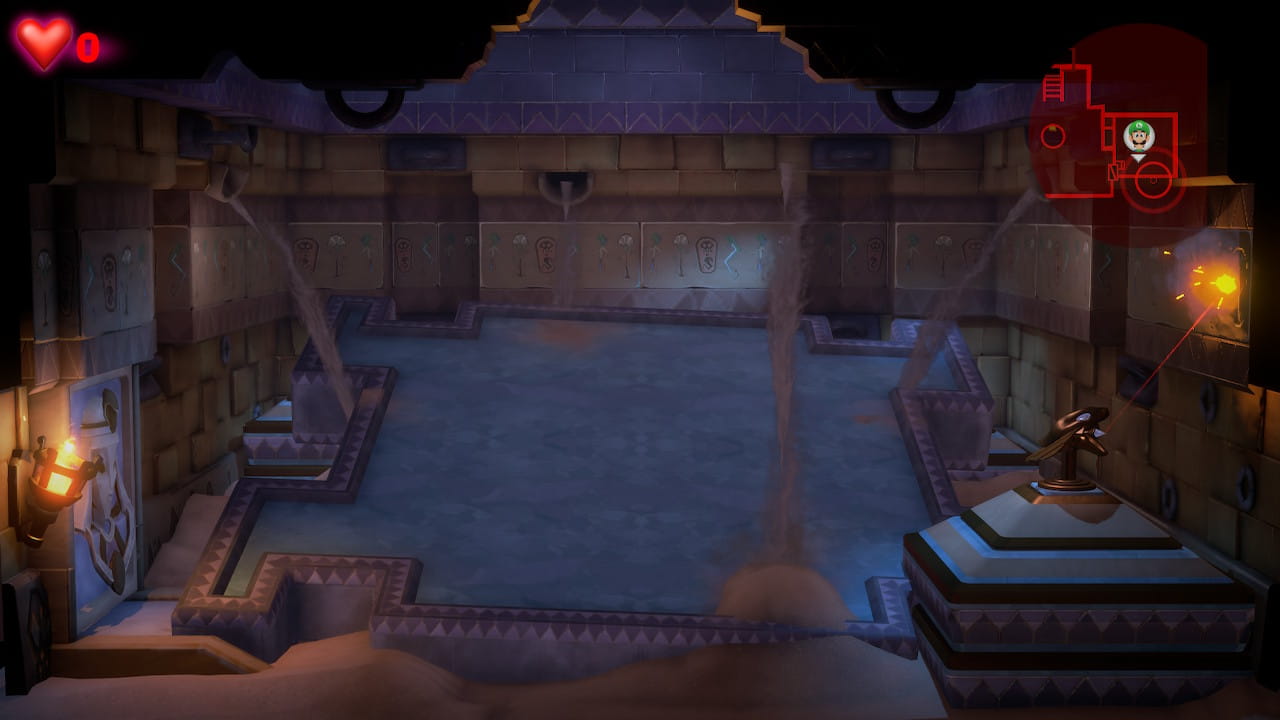
Bosses can also be rather unintuitive. The 2nd phase o’ the T. rex fight expects you to move Gooigi next to the T. rex so that it tries to eat Gooigi, stunning it long ’nough to hit it with an egg. The seemingly very similar method o’ having Gooigi lure the T. rex into shooting shockwaves @ him doesn’t work — then the T. rex will immediately swing its head round after you shoot the egg. Why it can stop its shockwave that fast but not stop eating Gooigi is a mystery, as is why you need Gooigi to be right next to the T. rex to make the T. rex try to eat it, when the T. rex looms o’er you no matter where you are in the room.
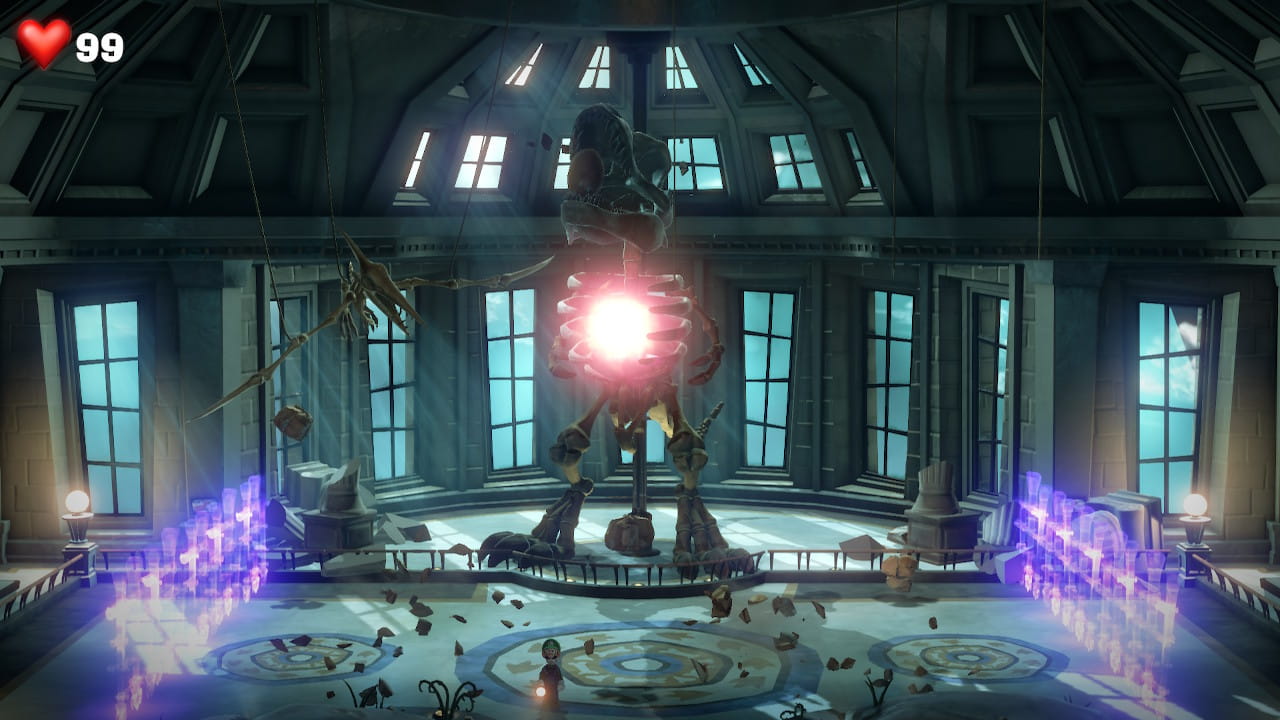
I’m also mixed on the hint that Polterpup gives you for the Johnny Deepend fight. I wasted a lot o’ time trying to sneak Gooigi o’er to the switch, only to keep getting sprayed by water, e’en tho I had already come up with the idea o’ smacking Deepend with a volleyball ( the most obvious idea ), simply ’cause Polterpup hanging round the switch seemed like the game was explicitly telling me, “1st you have to get Gooigi to hit the switch”. I had to ignore this hint to figure out the actual solution. On the other hand, you need to distract Deepend with Gooigi to get the chance to hit him with the ball as Luigi, & I guess Gooigi going toward the switch is a way to do that. I still feel as if Polterpup got in the way o’ my progress o’ already figuring out the puzzle, rather than helping in any way, which feels cheap. It’s better to give no hints than give bad hints.
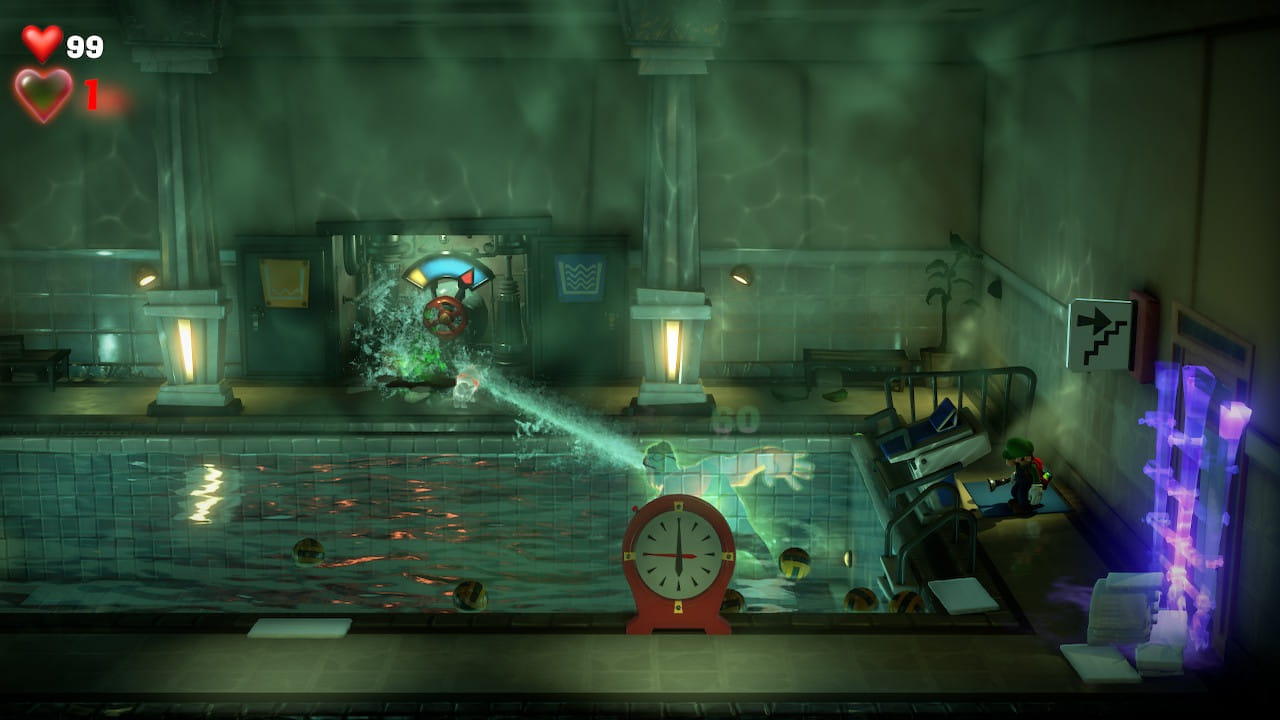
Speaking o’ bosses, they’re pretty weak, which is unfortunate, as a few floors are just a few rooms & a disappointing boss. I cannot fully communicate how sad I am that they squandered the cool theme used for “The Dance Hall” simply for the small intro to a boss that’s just a mo’ simplistic variation o’ the main mechanic o’ the magicians from “Twisted Suites”, which was a fully-developed level. Almost all bosses in this game are Rareware Bosses with phases where you just dodge shit for a while & then you get 1 hit in on them, rinse repeat. ¿Does anyone like these bosses? They’re transparently lazy compared to developing a boss with actually interesting interaction & make fights feel slower & drawn out. They’re basically inherent padding. What makes it dumber is they throw virtually infinite hearts @ you, so there isn’t e’en much urgency to avoid getting hit — which is somewhat good, since some o’ these bosses are cheap. The knight ghost has a magical hit box that makes its jousting stick warp you to its end, e’en when you’re clearly inches ’way from it. ( Meanwhile, it’s a coin-flip whether or not flashing the knight’s face will actually stun it; if it doesn’t, have fun waiting while the knight rides round the edges ’gain ).
I’m close to thinking the best boss is the penultimate Hellen Gravely boss, who requires you to go back & forth ’tween moving Luigi & Gooigi, moving Luigi to keep him safe from the lasers ’bove & Hellen’s attacks & moving Gooigi below to turn off the lasers ’bove so Luigi has room to suck up Hellen, with the urgency o’ needing to act quickly before Hellen turns on the water below & kills Gooigi, forcing the player to restart. It can be annoying & a li’l cheap, specially on the last phase, as Hellen just keeps undoing the progress, which can make what you do feel a bit repetitive. Also, Luigi’s weird explosion attack that late in-game acts as a jump, well, is a shitty ’scuse for a jump with a noticeable delay, which is terrible for trying to dodge a laser that accelerates as it moves, & which needs to be moving fast ’nough to not land back on top o’ it. It feels like something you’d see in a Super Mario World rom hack whose developer realized a mechanic not meant for a certain puzzle can be jankily used for that puzzle. This boss also doesn’t just throw hearts @ you left & right, making it an actual challenge.
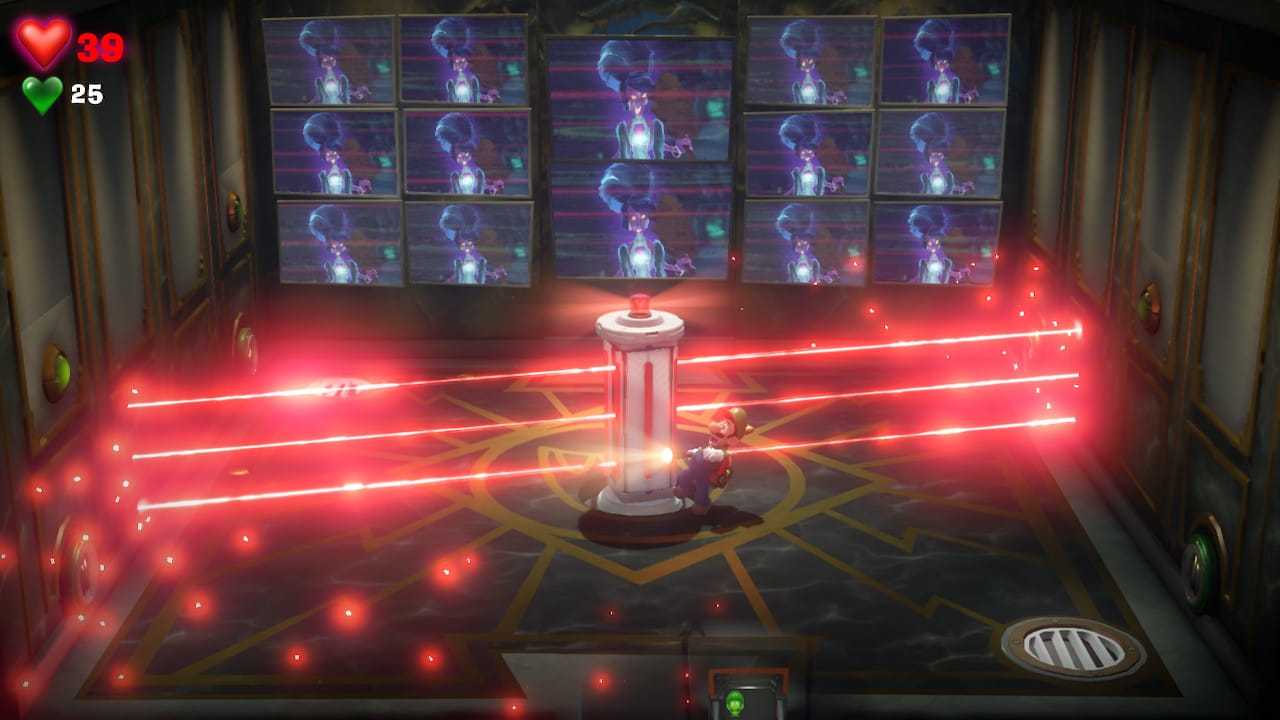
But what ruins Hellen is that some idiot decided to make it so that if you lose to the boss, you have to mash thru the whole cutscene ’gain. I stared with wide eyes as this horrific realization came to me the 1st time I died to her. ¿What game in 2019 has unskippable cutscenes @ all, much less unskippable cutscenes after beating a boss? ¿Did nobody playtest losing to the penultimate boss? The problem is that they just make you reload your save when you die ( forcing you to load what you’ve already loaded ), ’stead o’ just letting you restart the boss immediately, as a well-programmed game would do. What makes it most maddening is that the final boss does just restart you @ the final boss3.
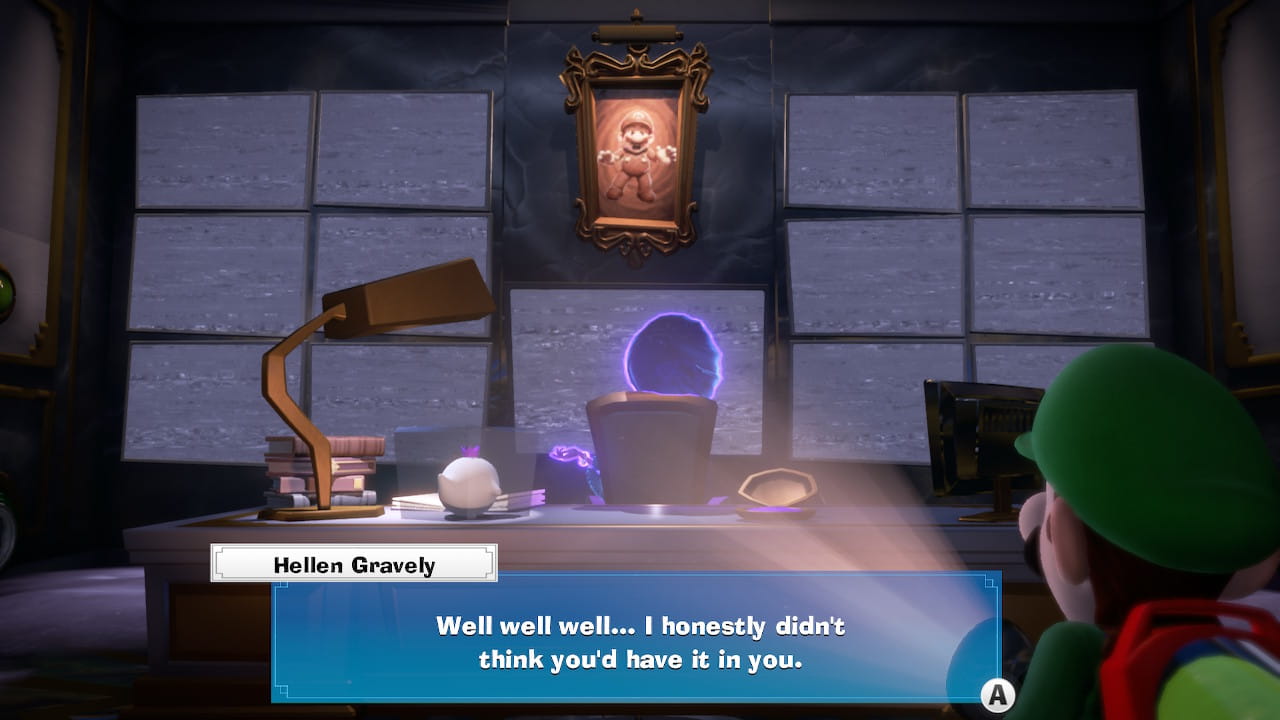
It’s annoying ’cause you know if you make this reasonable complaint some douche bag will retort, “just git gud”, proving that they’re too dumb to be worth listening to; but the problem isn’t losing itself, but that the developers contrived some idiotic extra punishment for losing that slows down my playing momentum & just wastes my time. This is a maddeningly common problem in modern games & is why I sometimes prefer games like Lost Levels o’er easier games: a’least Lost Levels doesn’t make me mash thru a bunch o’ bullshit just to retry a level. It’s 1 thing to make me retry a level when I lose: that’s necessary for the challenge to actually work. I’d be annoyed if I died @ a tough level & then the game just warped me back to where I died & didn’t let me try to challenge ’gain properly. ¿But what does seeing a cutscene ’gain have to do with the challenge? ¿Why would anyone e’er want to see a cutscene a 2nd time so soon? Imagine if after every time you died in some classic NES game they made you read the same scene o’ Hamlet. So if you die on level 3 o’ Ghost ’n Goblins a dozen times, you have to read Act 1, Scene 3 o’ Hamlet each time. You’d despite that scene o’ Hamlet by then & ne’er want to read it ’gain in your life. That’s why nobody e’er reads books mo’ than a couple times in 1 sitting & why nobody should e’er have to watch a cutscene — which, let’s face it, is no Hamlet — mo’ than once in the same playthru.
Technically, you can buy bones to maybe avoid the cutscene. I don’t know ’cause I’ve ne’er bought a bone, ’cause they’re otherwise useless, since the game autosaves after every room. These bones are the perfect example o’ a game implementing a mechanic, despite having no use in this iteration o’ the series, simply ’cause an earlier game did. Some may find this 1 convenience clever, but I find it stupid needing to think to buy an otherwise useless item just to avoid having to waste time on a long cutscene.
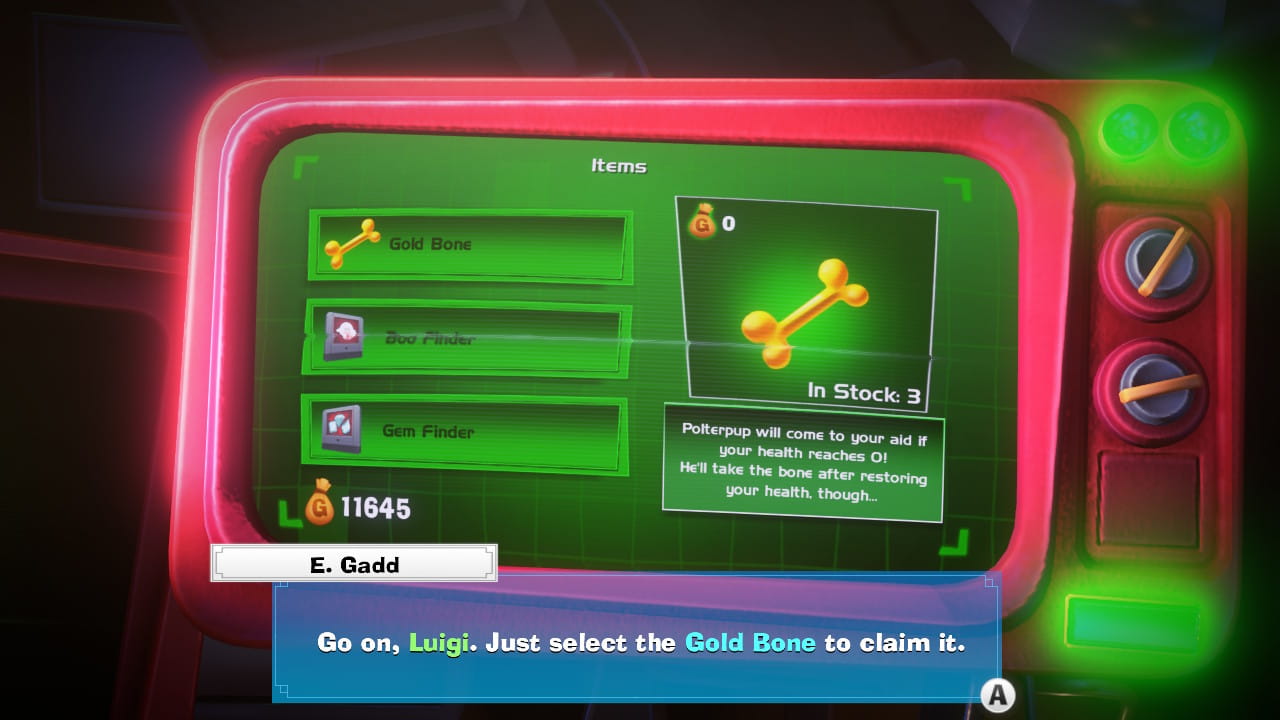
But the worst boss in the game has to be the final King Boo boss. O’ all the Rareware bosses in this game, this is the Rarewariest. ’Cept in Rare’s defense, e’en a boss as tedious & repetitive as the final K. Rool boss from Donkey Kong Country a’least works solidly & is intuitive. Many o’ the mechanics in this boss, such as tossing a bomb into King Boo’s mouth or pulling on his tongue, don’t work half the time, forcing you to wait thru mo’ generic attacks, like making you run to the 1 spot where they don’t shoot lightning down or making you dodge fireballs, if you miss your chance ’cause throwing the bomb didn’t work or the 1st few times I tried to attack King Boo after I did manage to blow him up, ’cause after I tried to vacuum his tongue & failed, I tried doing other things till, in desperation, I tried his tongue ’gain the 3rd time only to find, to my surprise, that this time I magically worked now. In the final phase, you have a time limit, which means if the bomb just bounces off King Boo’s open mouth or if the motion control bullshit just suddenly swings your aim in a different direction right as you shoot too many times, you’ll have to do the whole boss all o’er ’gain.

This is worsened by the fact that this is the most generic boss in this game, who could fit into virtually any 3D game, it requires you to use Luigi’s Mansion mechanics so sparingly & shallowly. Most o’ the challenge is dodging things, whether it be fireballs, lightning, tongues, spike balls, or bombs. None o’ it is challenging, ’cept for maybe trying to jump o’er the tongues when they rotate toward you thanks to the aforementioned jankiness o’ Luigi’s “jump” & the wonky hitboxes on the tongues, & unlike Hellen, this boss goes back to just throwing hearts @ you left & right, so the only true danger is the timer on the final phase; but you have no idea how mind-breakingly tedious it is to do them o’er & o’er & o’er ’gain. It’s annoying, ’cause it makes this boss’s 1 clever element terrible: during the 2nd & final phase, he splits into copies, only 1 o’ which is genuine & is actually affected by getting a bomb thrown into their mouth. This is telegraphed in many subtle ways, the most prominent being that the real King Boo has 4 teeth, while the fakes have 2 ( a clever callback to how King Boo looked in the original Luigi’s Mansion ). This would be cool if missing out on this fact a few times didn’t make you waste several mo’ minutes dodging fireballs that will ne’er hit me if their life depended on it.
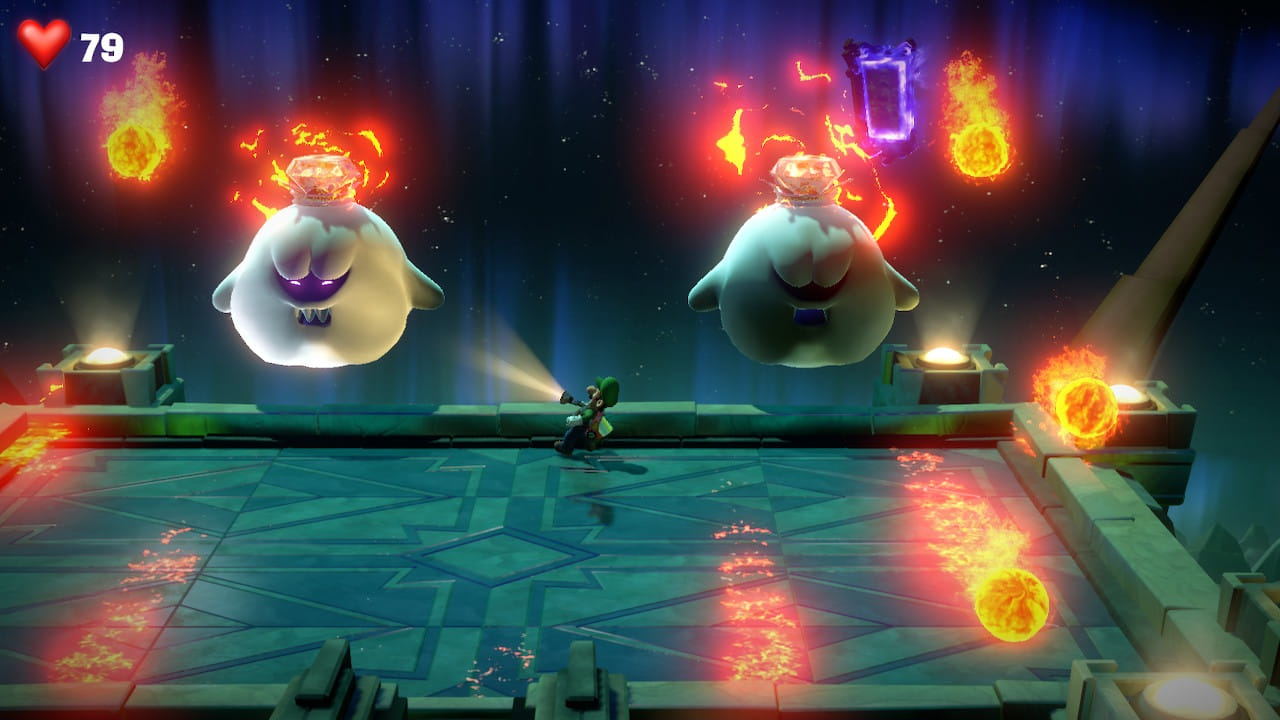
What makes this lame final boss mo’ annoying is the way they tease a much better boss. They have you rescue Mario after beating Hellen Gravely & have Mario lead Luigi up to the final battle, which makes you think you’ll get to have Mario helping you during the final boss, which would be a cool twist to the series.4 But for some asinine reason, King Boo just puts everyone back into the painting, ’cept for Luigi simply ’cause o’ a Deus Ex Machina thrown in using Polterpup. ¿Then what was the point o’ rescuing Mario before Peach? ¿Just to trick the player? ¿Why on earth would the developers o’ this game think leading players into thinking they’ll get an awesome boss battle with Mario assisting you only to deliver a generic Rareware boss would in any way produce a positive effect on players?
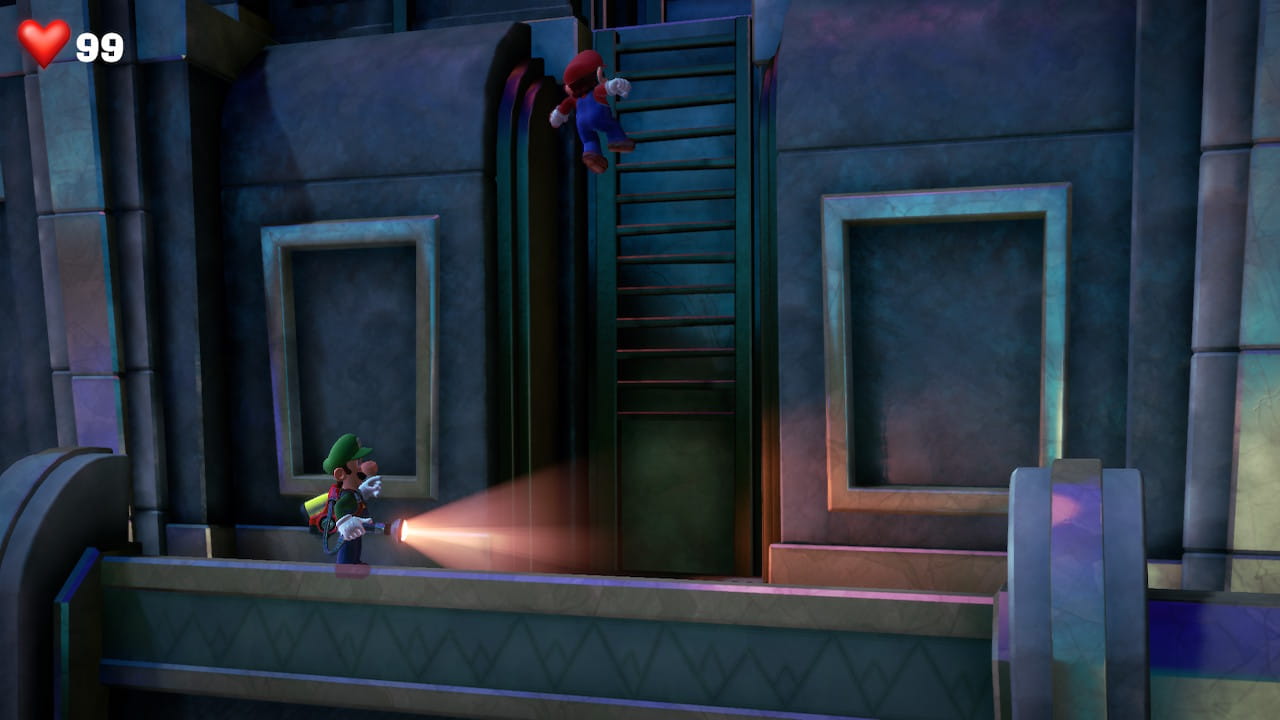
Many people online criticize Polterkitty as being padding. I agree that the boss itself is unintuitive when you 1st fight them & repetitive on subsequent fights. For some reason she’s impervious to being flashed in the face ’cept when she’s right ’bout to pounce on Luigi. I guess it’s s’posed to be ’cause her paws are right under her eyes as she’s creeping; but they’re right under her eyes just before pouncing, too.
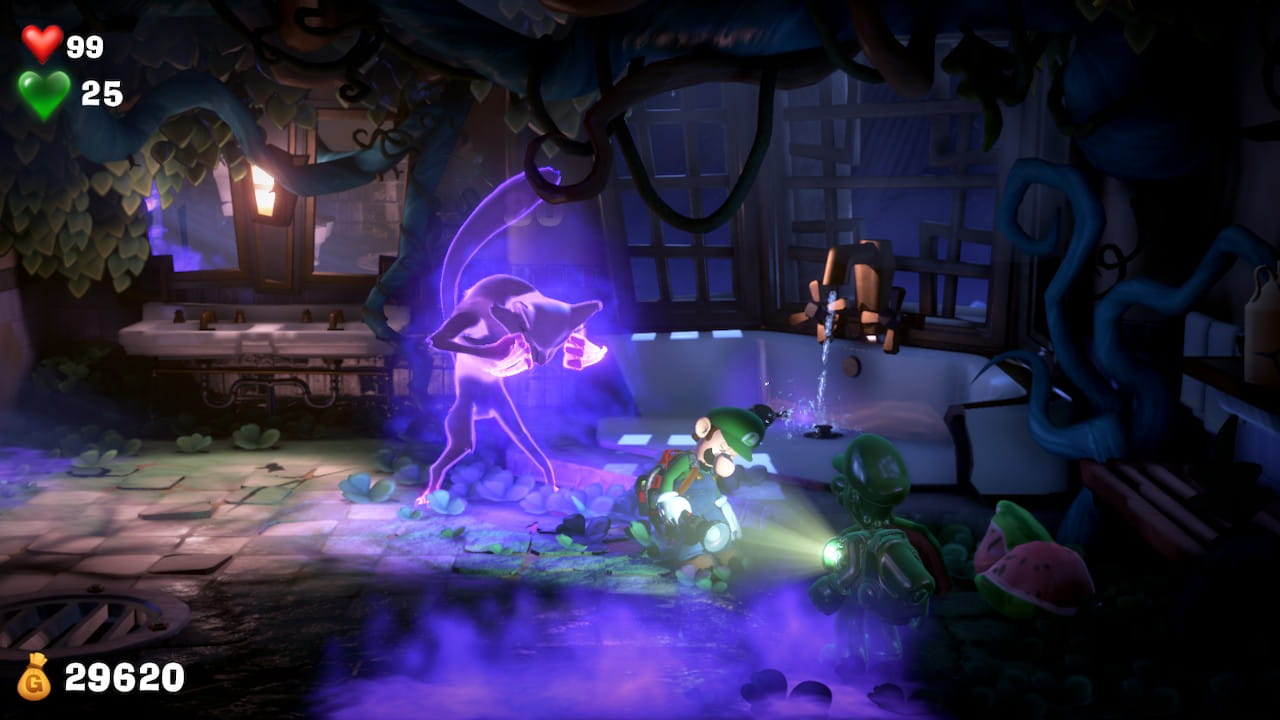
But the idea o’ making you go back & re-explore past hotel floors, e’en making you go thru multiple floors, is a nice ’way to encourage a less linear exploration than the level’s proper gave you. If anything, I think the problem is that they only have to explore 1 or 2 other floors before it ends. I think this mechanic would’ve worked better if they made it postgame & had you explore most o’ the floors & made where you have to explore randomized. That way it’d feel like a sort o’ final exam wherein you have to treat the hotel as a whole as a level, rather than individual floors.
The final question is, ¿how does Luigi’s Mansion 3 compare to either o’ its predecessors? As mentioned, none o’ the Luigi’s Mansion games had good combat, & Luigi’s Mansion 3 a’least makes it less tedious while also offering a few mo’ options to add variety, too. & despite my long rant ’bout Luigi’s Mansion 3’s bosses, it probably still has generally better bosses than its predecessors. The original & Dark Moon, too, had Rareware bosses that were either tedious or forgetful. The only bosses worth caring ’bout were 2 bosses in Dark Moon: the Grouchy Possessor ( the spider ) & the final boss. If not for the cutscene problem, Hellen Gravely would be the best boss in the series, & if not her, the magicians on the 12th floor, Johnny Deepend, or Captain Fishhook would be. E’en with the unintuitive puzzle for the 2nd phase during the T. rex fight, it’s still mo’ interesting than any boss in the original & most from Dark Moon. It says something that tho Amadeus Wolfgeist is a generic Rareware boss, it’s still better in every way than the utterly forgetful & pointless piano boss in Dark Moon, the Harsh Possessor.
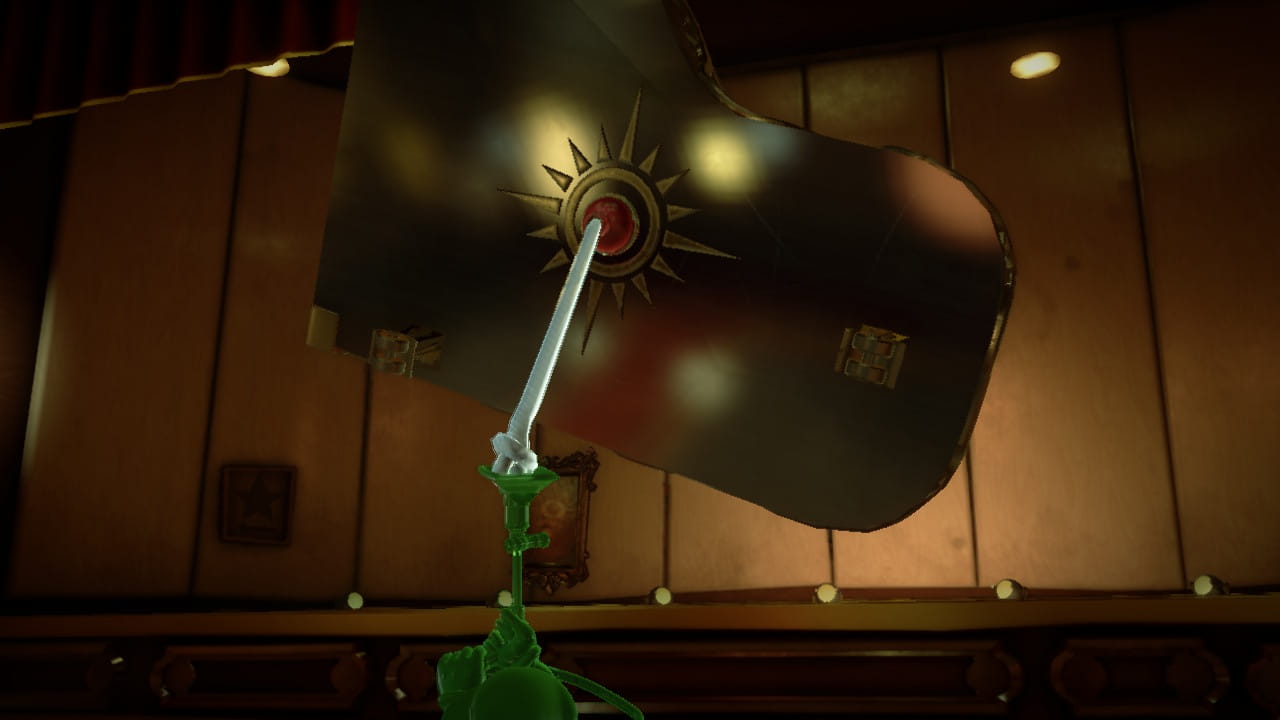
Most o’ the internet seems to agree that it’s better than the very controversial Dark Moon, but many still cling to the original for some vague magic that I have heard described in many games that basically just boils down to nostalgia. People seemed mixed on whether or not this game better matches the “dark atmosphere” o’ the original. They’re mixed ’cause the only special “dark atmosphere” o’ the original is made-up in their heads — probably memories from when they were young & had mo’ fragile sensibilities. Yes, it’s shocking that newer Luigi’s Mansion games are less scary now that you’re in your late 20s. The fact is that the original Luigi’s Mansion was just as goofy as the other 2. For instance, its final boss is the goofiest o’ them, involving King Boo dressing as Bowser, putting on Bowser’s head upside down & running round like a Looney Tunes character. & I don’t know what humans these nostalgic people know in real life, but “realistic” is not how I would describe the portrait ghosts o’ the original game. The only halfway creepy thing ’bout the original Luigi’s Mansion is the shadow glitch that appears during the blackout that makes it look like Luigi’s shadow is being hung from the rafters — & that was on accident. If one wants genuine horror, there are much better series to look than the 1 starring an italian plumber with a vacuum who acts like the video-game equivalent to Scooby Doo, including being barely able to talk.
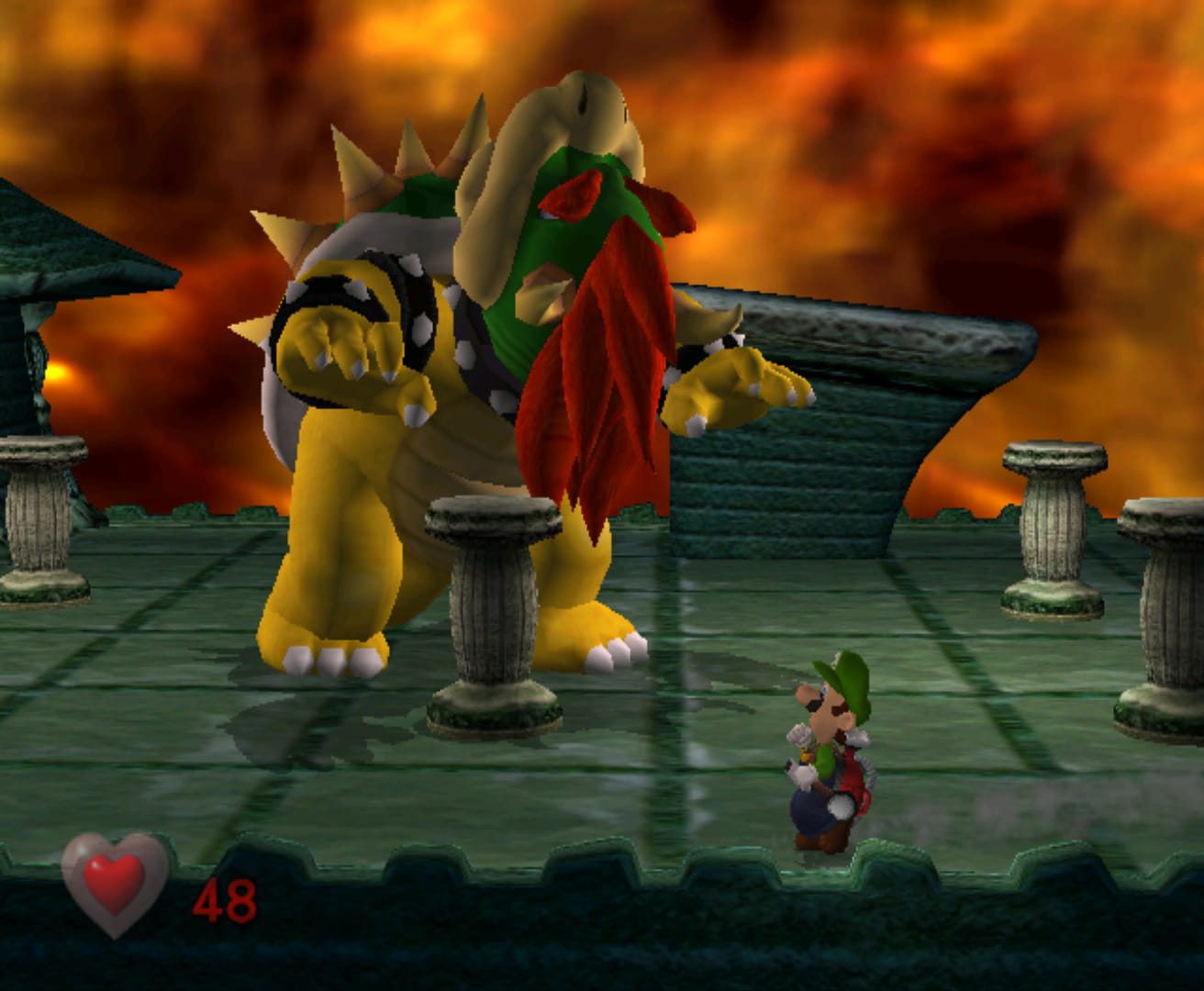
Music is the 1 thing this game may do worse than its predecessors. It, ’long with Dark Moon’s, are definitely weaker than Totaka & Tanaka’s music in the original. While Dark Moon had a catchy main theme, ’twas remixed for every level, lending that game li’l musical variety. This game has the most musical variety in terms o’ styles, — ’nough to almost hide the fact that each level’s melody is round the same, just @ different tempos — but none o’ the melodies stand out as much to me, & the instruments, like Dark Moon’s, are mostly cliché stock haunted instruments, while the original’s music felt unique with its blend o’ horror instruments spiced with hip hop & techno. Still, there are a few highlights, such as the use o’ harmonica & banjos in “B2 Boilerworks” or the slight surf rock to Johnny Deepend’s theme, which a’least feels fresh for a Luigi’s Mansion game. I also like the weird strings in the Polterkitty boss fight, which is the closest this game comes to sounding as weird as the original. “F3 Hotel Shops” & the DJ Phantasmagloria battle themes were the catchiest to me.
The visuals are, ’course, much better than its predecessors from much weaker consoles. & surprisingly, that’s not just my tastes: I was surprised by how many people I saw online who said Luigi’s Mansion 3 before e’en Breath of the Wild when asked which game they thought looked best. I only have 1 caveat: I was always disappointed that the Switch didn’t replicate the 3DS’s 3D capabilites. Dark Moon & the 3DS remake o’ the original were the highlight games for the 3DS’s 3D, as it brought out the strangeness o’ those games’ art design e’en mo’.

